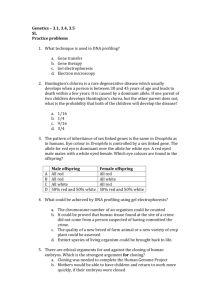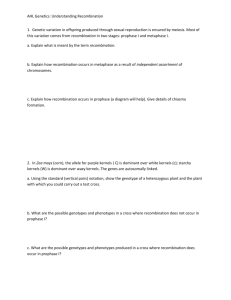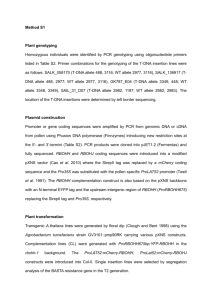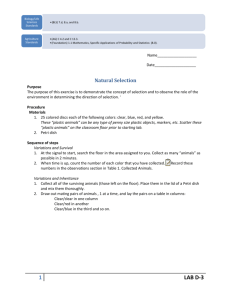Genetics HL Practice problems What technique is used in DNA
advertisement
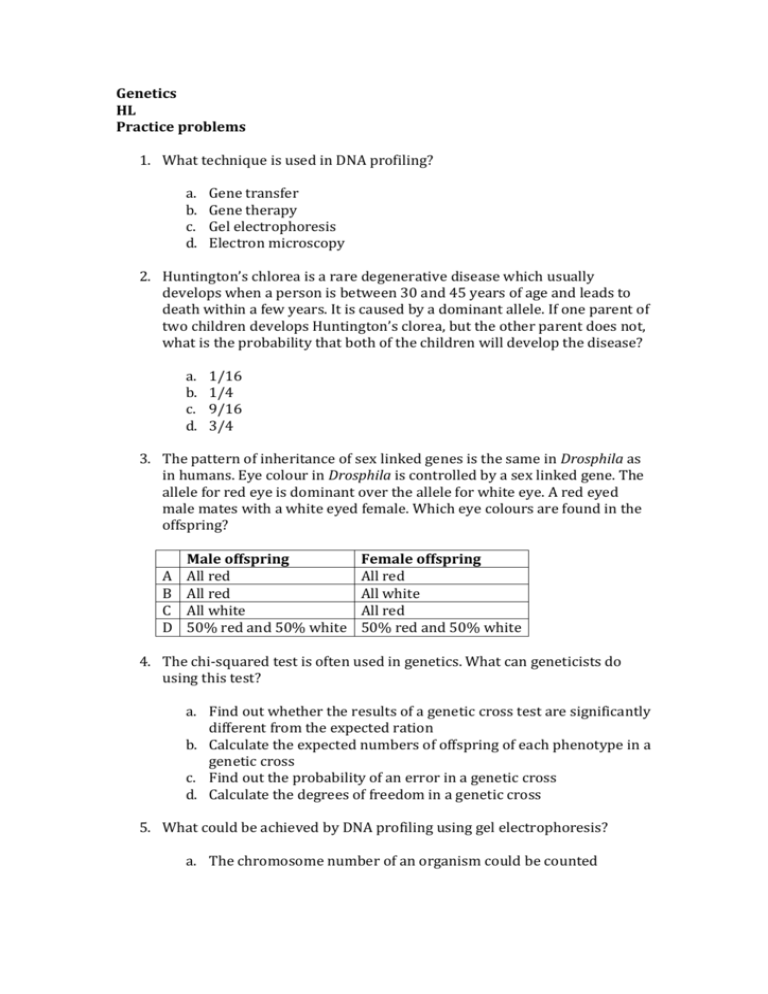
Genetics HL Practice problems 1. What technique is used in DNA profiling? a. b. c. d. Gene transfer Gene therapy Gel electrophoresis Electron microscopy 2. Huntington’s chlorea is a rare degenerative disease which usually develops when a person is between 30 and 45 years of age and leads to death within a few years. It is caused by a dominant allele. If one parent of two children develops Huntington’s clorea, but the other parent does not, what is the probability that both of the children will develop the disease? a. b. c. d. 1/16 1/4 9/16 3/4 3. The pattern of inheritance of sex linked genes is the same in Drosphila as in humans. Eye colour in Drosphila is controlled by a sex linked gene. The allele for red eye is dominant over the allele for white eye. A red eyed male mates with a white eyed female. Which eye colours are found in the offspring? A B C D Male offspring All red All red All white 50% red and 50% white Female offspring All red All white All red 50% red and 50% white 4. The chi-squared test is often used in genetics. What can geneticists do using this test? a. Find out whether the results of a genetic cross test are significantly different from the expected ration b. Calculate the expected numbers of offspring of each phenotype in a genetic cross c. Find out the probability of an error in a genetic cross d. Calculate the degrees of freedom in a genetic cross 5. What could be achieved by DNA profiling using gel electrophoresis? a. The chromosome number of an organism could be counted b. It could be proved that human tissue found at the site of a crime did not come from a person suspected of having committed the crime. c. The quality of a new breed of farm animal or a new variety of crop plant could be assessed d. Extinct species of living organism could be brought back to life. 6. There are ethical arguments for and against the cloning of human embryos. Which is the strongest argument for cloning? a. Cloning was needed to complete the Human Genome Project b. Mothers would be able to have children and return to work more quickly, if their embryos were cloned c. Cloning allows parents to choose the characteristics of their children d. Cloning happened naturally when identical twins are formed. 7. In the Japanese Morning Glory plant (Pharbitus nil), flowers can be red, blue or purple. The genotypes which give each of the three flower colours are shown below: Red Blue Purple aabb A-BA-bb, or aaB- Which cross would give a ratio of 2 red:6 blue: 8 purple in the offspring? a. b. c. d. AaBb x AaBb AaBb x aabb AaBB x AABb AaBb x Aabb 8. A healthy couple have a daughter who has a rare disease caused by a recessive mutation of a gene. They then have two healthy children. What is the probability that a fourth child will have the same rare disease? a. b. c. d. 0.00 0.25 0.50 0.75 9. What is a clone? a. A group of organisms which could interbreed and produce fertile offspring b. A group of cells descended from two parent cells c. A group of organisms of the same species living together and interbreeding d. A group of organisms with identical genotype. 10. Which enzymes are needed to produce recombinant plasmids that are used in gene transfer? a. b. c. d. DNA polymerase and ligase DNA polymerase and restriction enzymes Restriction enzymes and ligase Helicase and restriction enzymes 11. In garden peas, the pairs of alleles coding for seed shape and seed colour are unlinked. The allele for smooth seeds (S) is dominant over the allele for wrinkled seeds (s). The allele for yellow seeds (Y) is dominant over the allele for green seeds (y). If a plant of genotype Ssyy is crossed with a plant of genotype ssYy, which offspring are recombinants? a. b. c. d. SsYy and Ssyy SsYy and ssYy SsYy and ssyy Ssyy and ssYy 12. What constitutes a linkage group? a. b. c. d. Genes carried on the same chromosome Genes whose loci are on different autosomes Genes controlling a polygenic characteristic Alleles for the inheritance of ABO blood groups 13. The pedigree chart below shows the inheritance of Daltonism in a family. Daltonism (red-green colour blindness) is sex linked. The allele for Daltonism is recessive to normal colour vision. Persons I and II have a child. What is the chance that the child will be colour blind? a. 0% b. 25% c. 75% d. 100% 14. What is copied by the polymerase chain reaction (PCR)? a. Polypeptides b. Polysaccharides c. Poly nucleotides d. Polyunsaturated fats 15. When does recombination take place? a. Only when linked genes cross over b. When non-linked genes cross over and when linked genes show independent assortment c. Only when linked genes show independent assortment d. When non-linked genes show independent assortment and when linked genes show crossing over. 16. Mendel’s Second Law is the Law of Independent Assortment. The first exception to this law was discovered in 1905, by Bateson, Saunders and Punnett. The two genes involved, which control flower colour and pollen grain shape in Lathyrus odoratus (the sweet pea), did not show independent assortment because they are part of the same linkage group. a. Define linkage group (1) The allele for purple flowers (P) is dominant over the allele for red flowers (p) The allele for long pollen (L) is dominant over the allele for short pollen (l) A cross was made between a plant that was heterozygous for both genes and another plant that was homozygous for the recessive allele of both genes. Four different phenotypes were found in the offspring. The phenotypes and the percentage of each are shown in the table below. Phenotypes of the offspring Purple flowers and long pollen grains Purple flowers and short pollen grains Red flowers and long pollen grains Red flowers and short pollen grains Percentage 44 6 6 44 b. Identify which of these offspring are recombinants. Give a reason for your answer (2) c. Explain briefly how the recombinants are formed when two genes are linked (2) The genotypes of the two parent plants used in the cross are shown below. d. Deduce the genotype of each of the offspring and list them in the table below (2) Phenotypes of the offspring Genotype Purple flowers and long pollen grains Purple flowers and short pollen grains Red flowers and long pollen grains Red flowers and short pollen grains 17. Nephrogenic diabetes insipidus is a rare genetic disease. In one family affected by the disease, geneticists found a mutation in the gene coding for the ADH receptor protein. In the mutant allele there is a stop codon instead of a codon for the amino acid tryptophan at position 284. a. State the type of mutation that converts one codon into another (1) b. Predict the effect of converting a codon in the middle of a gene into a stop codon (2) The pedigree chart below shows which members of the family were affected by Nephrogenic diabetes insipidus and which were unaffected. c. Explain, using the pedigree chart, whether the allele causing the disease is dominant or recessive. (2) d. The pattern of inheritance shown in the pedigree chart suggest that Nephrogenic diabetes insipidus is a sex linked condition. Evaluate the evidence provided by the pedigree chart for sexlinkage. (2) e. The hypothesis that the disease is sex-linked can be tested using the chi-squared test. If the disease was not sex-linked, one quarter of both males and female offspring would, on average, be affected. The numbers of affected and unaffected children are shown in the table below: i. Use this equation to calculate, O is the observed number of sons affected by the disease and E is the expected number of sons affected by the disease. (2) ii. The same calculation was done for unaffected sons, for affected daughters and for unaffected daughters. When all four results are added together the total is 10.66. This is the statistic chi-squared. Using the table below, deduce whether the observed and the expected results are significantly different and whether the hypothesis that the disease is sex-linked is supported or not. (2) 18. dsav



